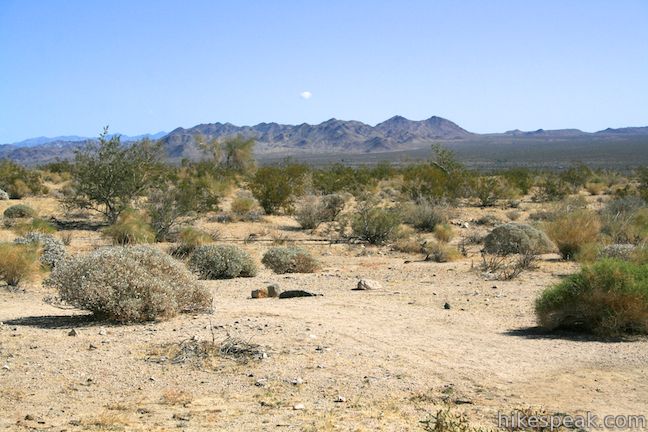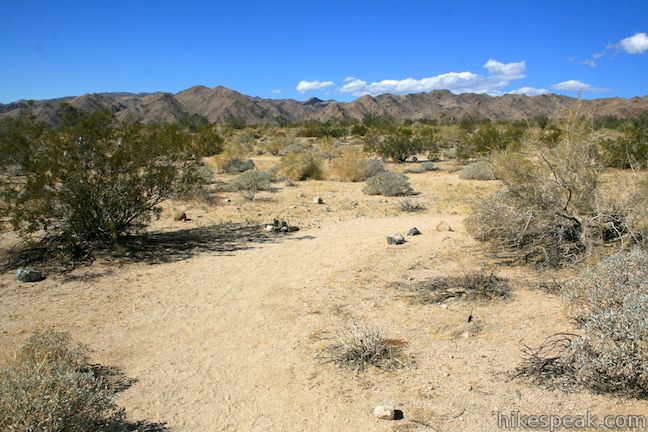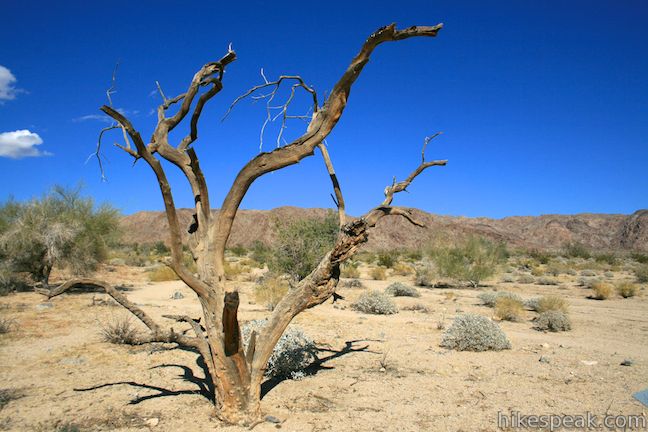
Bajada All-Access Nature Trail is located on the southeast side of Joshua Tree National Park between the 10 Freeway and the Cottonwood Visitor Center. The hike, which you could do in flip-flops or tennis shoes, is a 0.3-mile loop with about 5 feet of elevation change. If that wears you out, there are three benches along the way where you can pause to admire the vegetation and scenery. Sixteen panels along Bajada Trail describe the Colorado Desert plants that manage to survive on this bajada. Mountains surrounding this level loop create a powerful backdrop for an unimposing trail.

One of the first signs along Bajada All-Access Nature Trail explains what a bajada is and how this one is special:
A Bajada, or slope, at a mountain’s base, is formed of eroded sand and gravel. More moisture is trapped and available to plants in a course, well-drained soil. Plant growth begins earlier in the warmer soil of this south facing bajada, which allows a greater variety of plants to grow here than on the bajada across the valley.
The nature trail highlights some of the key plants that have found a way to survive on the bajada, like cacti, ocotillo, creosote bush, brittle bush, indigo bush, chuparosa, and palo verde. Only certain plants can tough it out in this environment, and another panel explains why life on a Colorado Desert bajada can be such a challenge:
The subtropical Sonoran Desert, with its higher rainfall and longer growing season, has the most diverse plant life of any America desert. However, the Colorado Desert, a subdivision of the Sonoran Desert, lies in the rainshadow of high mountain ranges. The combination of reduced rainfall and low elevations make this desert the hottest and driest in North America. how do plants and animals survive here? A complex web of interactions between each other and the environment allow the residents of the bajada community to thrive in an arid land.

As you walk around the level hard-packed loop, you’ll learn how each plant has adapted for survival in the desert. Cacti keep water in their stems and have spines to protect this cache from hungry animals and the harsh sun. Ocotillo grow quick leaves when it rains and drop them during long droughts. Brittle bush have big leaves during a wet period that shrink and become brittle during droughts. Palo Verde only grow leaves during a rainy period and can rely on their branches for photosynthesis during a drought. Each plant has devised a way to live where plants from other climates would wither and die.
Along the loop, you will also pass Ironwood trees, both alive and dead, a rare sighting for Joshua Tree:
Within Joshua Tree National Park, the frost-sensitive ironwood, a Sonoran Desert plant, is found solely on this bajada. Only here does it find enough warmth and moisture to meet its specialized needs. The ironwood, which can grow quite large, provides shelter for many shade-loving plants and animals.

In this arid landscape, a dead ironwood can remain standing for many years. You won’t be standing around for nearly as long because this quick and easy hike is over after 0.3 miles.
The loop is usually done in a counterclockwise direction. No permit is required to hike Bajada Trail. The trailhead is located within the boundaries of Joshua Tree National Park, but outside the area where you are required to stop and pay an entrance fee. To get more information about the park, drive 5.4 miles north of Bajada Trail to the Cottonwood Visitor Center, where you will also find nearby trails to Mastodon Peak and Lost Palms Oasis.
To get to the trailhead: From the 10 Freeway, take exit 168 and head north on Cottonwood Spring Road. After 1.5 miles, you will spot a parking area for Bajada Trail on the right (east) side of the road. Park and start on the trail beginning next to the kiosk. Bajada Trail is 5.4 miles south of the Cottonwood Visitor Center.
Trailhead address: Cottonwood Springs Road, Joshua Tree National Park, CA 92277
Trailhead coordinates: 33.681238, -115.801784 (33° 40′ 52.45″N 115° 48′ 06.42″W)
View Joshua Tree National Park in a larger map
Or view a regional map of surrounding California Desert trails and campgrounds.
 | Lost Palms Oasis This 7.2-mile hike visits a desert oasis nestled between mountains in the southeast corner of the park. |
 | Mastodon Peak This 2.6-mile loop visits a 3,400-foot summit with panoramic views of southeastern Joshua Tree. |
 | Cholla Cactus Garden This quarter-mile loop allows visitors to stroll through an intense concentration of cholla cacti. |
 | Hikes in the California Desert Explore more trails in Death Valley National Park, Joshua Tree National Park, Anza-Borrego Desert State Park, and Mojave National Preserve. |
 | Indian Cove in Joshua Tree National Park The 101-site campground is home to a 0.6-mile interpretive trail with information about plants and animals in the park. |
 | Elephant Trees Trail in Anza-Borrego Desert State Park This easy one-mile loop offers a lesson in desert botany including the rare elephant tree. |
 | Alcove Nature Trail in Colorado National Monument This one-mile round trip hike offers information about the plants, animals, and geology of the park. |
 | Ecology Trail in the San Gabriel Mountains This 2/3 of a mile lollipop loop will introduce you to numerous plants along with views of Placerita Canyon. |
 | Joshua Tree Campgrounds Nine campgrounds with 500 total sites are spread throughout the park to facilitate your visit. |
 | Joshua Tree Wildflowers The desert in bloom is something any outdoor enthusiast in California should see. |







[…] walk among the blooms and take pictures. I exited the Park at the south entrance and stopped at the Bajada Nature Trail for a short walk. I then headed […]